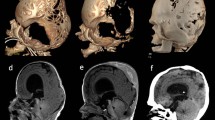Abstract
In children with syndromic craniofacial disorders, such as Crouzon and Apert syndromes, who are managed surgically, a difficult problem that can occur is secondary turricephaly. One of the more widely accepted theories as to why this deformity occurs is that a lack of skull base growth results from fusion of the basal and facial sutures. Despite initial adequate forehead and orbital bandeau advancement, many of these patients require subsequent procedures, which do not always correct the characteristic deformity. We have identified a subset of 11 syndromic children who developed this characteristic deformity of turricephaly after primary reconstruction, 6 of whom required either secondary or tertiary procedures. Only 5 patients had a good outcome with a mean follow up of 4.5 years (range 1–8 years). Our surgical methods, and our rationale for the timing of surgery are discussed, and the literature on the management of this problem is reviewed.
Similar content being viewed by others
References
Barone CM, Yule GJ, Concannon MJ (1995) Alternatives to autologous bone grafting in the craniofacial skeleton: distraction osteosynthesis and bone graft substitutes. In: Goodrich JT, Hall CD (eds) Craniofacial anomalies: growth and development from a surgical perspective. Thieme, New York, pp 162–173
Cohen MM (1986) The etiology of craniosynostosis. In: Cohen MM (ed) Craniosynostosis: diagnosis, evaluation, and management. Raven Press, New York, pp 59–79
Donauer E, Bernardy M, Neuenfeldt D (1993) T-bone plastique for treatment of brachy-turricephaly. Acta Neurochir (Wien) 120:126–131
Genitori L, Zanon N, Lena G, et al (1995) Oxycephaly: classification and surgical management. In: Goodrich JT, Hall CD (eds) Craniofacial anomalies: growth and development from a surgical perspective. Thieme, New York, pp 43–55
Goodrich JT (1991) Craniofacial reconstruction for craniosynostosis. In: Goodrich JT, Post KD, Argamaso RV (eds) Plastic techniques in neurosurgery. Thieme, New York, pp 75–108
Goodrich JT, Hall CD (1995) Evaluation and management of complications in craniofacial surgery. In: Goodrich JT, Hall CD (eds) Craniofacial anomalies: growth and development from a surgical perspective. Thieme, New York, pp 194–211
Goodrich JT, Hall CD (1995) Metopic synostosis and trigonocephaly: a spectrum of dysmorphology. In: Goodrich JT, Hall CD (eds) Craniofacial anomalies: growth and development from a surgical perspective. Thieme, New York, pp 97–106
Jane JA, Pershing JA (1986) Neurosurgical treatment of craniosynostosis. In: Cohen MM (ed) Craniosynostosis: diagnosis, evaluation, and management. Raven Press, New York, pp 249–320
Kreiborg S, Prydsoe U, Dahl E, et al (1976) Calvarium and cranial base in Apert's syndrome: an autopsy report. Cleft Palate J 13:296–303
Kroczek RA, Muhlbauer W, Zimmermann I (1986) Cloverleaf skull associated with Pfeiffer syndrome: pathology and management. Eur J Pediatr 145:442–445
Marchac D (1987) Discussion of: Whitaker LA, Bartlett SP, Schut L, et al (1987) Craniosynostosis: an analysis of the timing, treatment, and complications in 164 consecutive patients. Plast Reconstr Surg 80:207–212
Marchac D, Renier D (1985) Craniofacial surgery for craniosynostosis improves facial growth: a personal case review. Ann Plast Surg 14:43–54
Moss ML (1995) Growth and development of the craniofacial complex: an epigenetic viewpoint. In: Goodrich JT, Hall CD (eds) Craniofacial anomalies: growth and development from a surgical perspective. Thieme, New York, pp 1–7
Ousterhout DK, Melsen B (1982) Cranial base deformity in Apert's syndrome. Plast Reconstr Surg 69:254–263
Persing JA, Edgerton MT, Park TS, et al (1987) Barrel stave osteotomy for correction of turribrachycephaly craniosynostosis deformity. Ann Plast Surg 18:488–493
Persson KM, Roy WA, Persing JA, et al (1979) Craniofacial growth following experimental craniosynostosis and craniectomy in rabbits. J Neurosurg 50:187–197
Renier D, Marchac D (1995) Oxycephaly: an often complex diagnosis with a review of surgical managment. In: Goodrich JT, Hall CD (eds) Craniofacial anomalies: growth and development from a surgical perspective. Thieme, New York, pp 56–63
Stewart RE, Dixon G, Cohen A (1977) The pathogenesis of premature craniosynostosis in acrocephalosyndactyly (Apert's syndrome). Plast Reconstr Surg 59:699–707
Tessier P (1986) Craniofacial surgery in syndromic craniosynostosis. In: Cohen MM (ed) Craniosynostosis: diagnosis, evaluation, and management. Raven Press, New York, pp 321–411
Whitaker LA, Bartlett SP, Shut L, et al (1987) Craniosynostosis: an analysis of the timing, treatment, and complications in 164 consecutive patients. Plast Reconstr Surg 80:195–206
Wilkie AOM, Slaney SF, Oldridge M, et al (1995) Apert syndrome results from localized mutations of FGFR2 and is allelic with Crouzon syndrome. Nat Genet 9:165–172
Author information
Authors and Affiliations
Rights and permissions
About this article
Cite this article
Sonstein, W.J., Hall, C.D., Argamaso, R.V. et al. Management of secondary turricephaly in craniofacial surgery. Child's Nerv Syst 12, 705–712 (1996). https://doi.org/10.1007/BF00366155
Issue Date:
DOI: https://doi.org/10.1007/BF00366155




